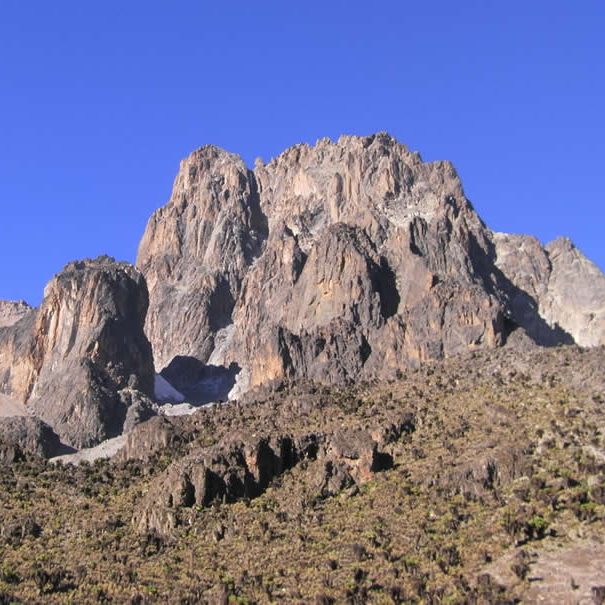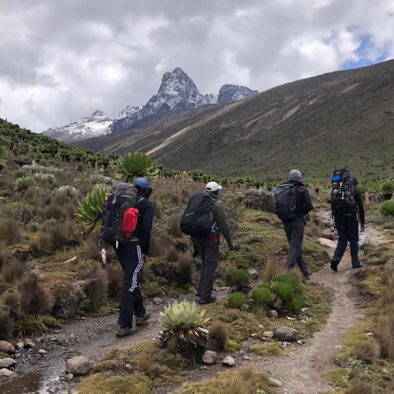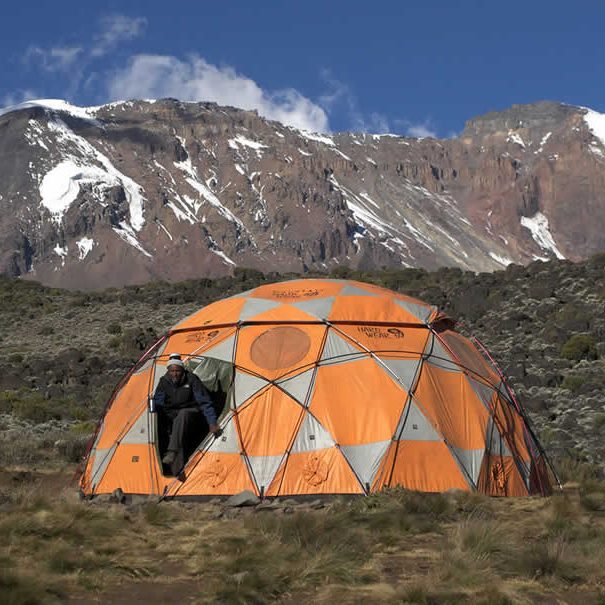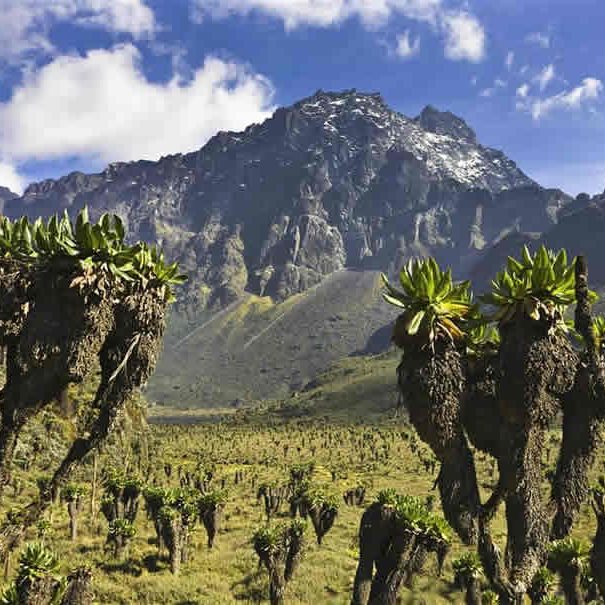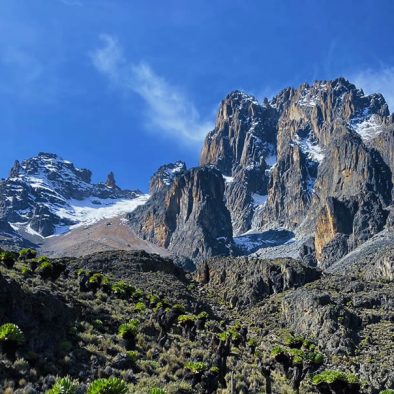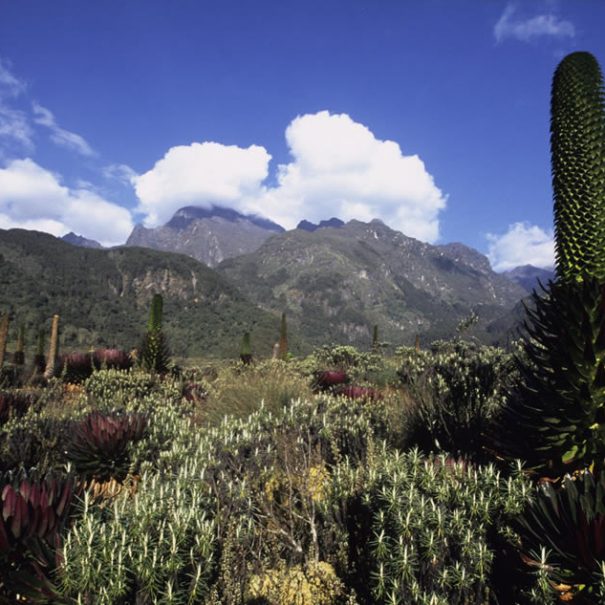Standing as the highest among Kenya’s mountains, Mount Kenya ascends slightly beyond 5,199 meters (17,000 feet) and claims the position of the second-highest peak in Africa. The massif is dominated by two principal summits: Batian and Nelion. These peaks, Batian and Nelion, stand as the highest points and demand proficient rock climbing and mountaineering skills for a successful conquest. Here we guide you on technical climbing of Mount Kenya peaks of Nelion and Batian.
Climbing the Nelion and Batian Peaks
The primary objective of the 8 Days Mount Kenya Technical Climb is to summit the peaks of Nelion and Batian, standing at 5199 meters (17,057 feet) and 5188 meters (17,021 feet) respectively. These summits represent the highest points on Mount Kenya, offering a truly unique African mountain hiking experience. Renowned as some of the finest technical alpine climbs globally, they are undeniably the highest technical climbing routes on the African continent.
Mount Kenya boasts approximately 35 documented technical climbing routes, but guided climbs primarily concentrate on two routes depending on the season: The North Face Standard Route and the Normal Standard Route (also known as the MacKinders Route). Batian is typically ascended via the North Face Standard Route from July to September, while Nelion is commonly climbed using the MacKinders Route from December to February.
The famed ice routes of the Diamond Couloir and Ice Window face south and are ideally tackled between June and October. However, the impact of global warming has significantly reduced the conditions suitable for these routes, and they are now rarely in optimal climbing conditions.
Both Nelion and Batian are crafted from Syenite, an exceptional rugged rock comparable to granite in climbing quality. These peaks boast numerous outstanding rock and ice routes, with the primary summits typically requiring a bivouac. However, satellite peaks like Point John provide excellent one-day climbing opportunities.

When many tourist groups discuss climbing Mount Kenya, they often refer to Point Lenana, a comparatively easier satellite peak. The true Mount Kenya experience involves a lengthy and challenging ascent, featuring numerous pitches of fifth-class rock climbing—these are not your typical trekking peaks!
The duration of your technical climb on Mount Kenya will hinge on your experience and fitness level. Accomplished climbers in prime physical condition may complete a technical climb in as few as 5 days. However, the majority of climbers will find 7 days or more necessary for a safe and comfortable ascent. The 8 Days Mount Kenya Technical Climb, focusing on Nelion and Batian Peaks, promises a challenging yet immensely rewarding adventure.
Crossing the Gates of Mist
For adept climbers, the option exists to cross the ‘Gates of Mist’ from Nelion Peak to Batian Peak. However, climbers must be ready to bivouac in Howell’s Hut, and the route across (a descent followed by a brief steep ascent) can frequently be covered in snow, particularly around December. The undertaking is notably challenging, particularly given the altitude, fatigue, and the urgency of descending before nightfall. It’s advisable to attempt this only in optimal conditions and with ample time available.
WHEN TO CLIMB MT KENYA
Rain and snow are potential throughout the year on Mount Kenya, with the highest rainfall occurring over the forest and the southeast side of the mountain from March to May, and slightly less from October to December. The driest period on the south side is late December to February, characterized by long stable days offering generally excellent climbing conditions, although snow at higher elevations should still be anticipated.
Late December to February is the time when the south side of the mountain receives the most sunshine, rendering the rock in good condition with a reduced likelihood of ice. However, expect isolated patches in the gullies. Conversely, June to October is optimal for south-facing ice climbing or the north-facing rock climb on Batian.
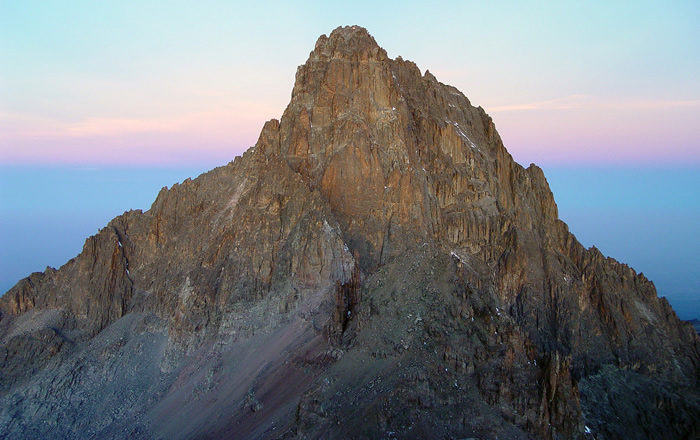
Temperatures fluctuate, becoming colder with increasing altitude and depending on the time of day. Anticipate daytime temperatures ranging from 5 to 15°C, while nighttime temperatures fall well below freezing, with frost becoming prevalent around the 3000-meter mark.
Hiking Routes up Mt Kenya
- Meru
- Chogoria
- Kamweti
- Naro Moru
- Burguret
- Sirimon
- Timau
- Peak Circuit Path
Most hikers go up and down a combination of three routes – Naro Moru, Sirimon and Chogoria – which generally take about five to six days to complete. These three routes also feature staffed gates which make them the most frequently used, while the other routes require special permission from the Kenya Wildlife Service to hike.
Recommended Technical Climbing Gear for Nelion and Batian Peaks on Mount Kenya
- Climbing Ropes and Harness
- Helmet
- Rock Shoes
- Belay or Rappel Plate
- Karabiners
- Slings
- Prussic Loops
Navigating the Challenges of Mount Kenya’s Technical Climbs
The primary obstacle faced by trekkers is often not the physical strain but the impact of thinning air, notably evident beyond the 3000m mark.
Reaching the summit of Nelion entails a prolonged day of climbing, encompassing approximately 18 pitches. The technical grading, spanning between scramble and UIAA IV+, with an average around UIAA II, underscores the climb’s challenging nature. Batian Peak demands a comparable day-long ascent, featuring up to 21 pitches ranging from low-grade scramble to UIAA IV+, with an average around UIAA II.
Beyond technical grading, additional factors impact the difficulty and safety of advanced climbs. The substantial length necessitates both physical stamina and mental focus, demanding up to 11 hours of sustained effort. While guided tours typically facilitate acclimatization, the elevated altitude exacerbates climber fatigue.
Moreover, potential challenges include unpredictable weather conditions, which can be mitigated by choosing an optimal time for the route and incorporating a “weather day” for insurance. Additionally, the absence of sophisticated rescue facilities, commonplace in the European Alps, underscores the importance of careful consideration when assessing the difficulty of the trek-climb combination on Mount Kenya.


